Lacto-fermented Berries Recipe
Oh Lardy! is a participant in the Amazon Services LLC Associates Program, an affiliate advertising program designed to provide a means for us to earn fees by linking to Amazon.com and affiliated sites.
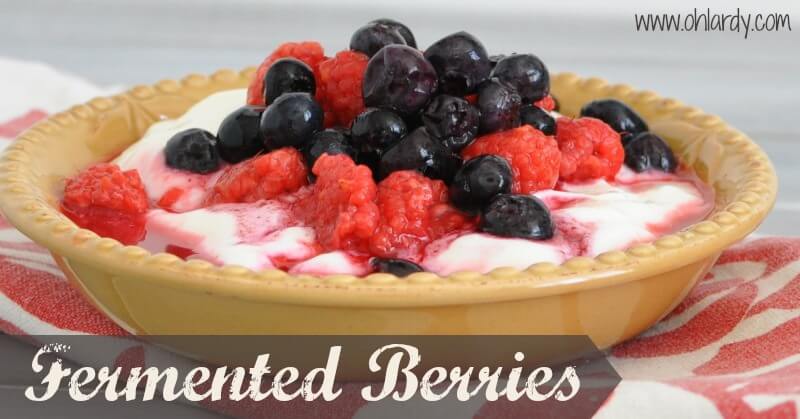
Adding fermented foods to your diet has many benefits. Fermented foods have increased vitamins and enzymes, are easier to digest, increase the amount of good bacteria in your gut and can help your immune system. What a great way to keep healthy this winter!!!
Culturing your own fruits and vegetables at home is a very cost effective way of getting probiotics into your diet. Plus, it is fun! Like a science experiment on your kitchen counter.
Cultured berries is one of my favorite fermented foods. It is so easy and you can use them on so many things! Everyone loves them and it is a great way to get probiotic foods into your family's diet!
You can use any berries, except strawberries. Strawberries do not ferment well, which are too acidic for lacto-fermentation, according to the Nourishing Traditions book. I have never tried so if you have successfully fermented strawberries, let us know in the comments!
To make 1 pint of cultured berries, you will want to start with 2 cups of fresh berries (blueberries, boysenberries, raspberries, blackberries or a mixture). I have had success with frozen berries as well, just be sure there are no funky additives. Be sure they are washed and leaves, stems, etc. are picked out.
Put the berries into clean 1 pint jars, pressing down to squish them a little. You can mix the berries together. I chose to keep them separate this time. Be sure to leave about an inch of space at the top of the jar.
For each 1 pint jar, mix 2 tbsp rapadura or honey, 1/4 tsp sea salt, 2 tbsp of whey OR 1/2 tsp culture starter and about 2-3 tbsp filtered water (if you are using Culture Starter, you can use an additional tbsp of water) in a measuring cup.
Pour slowly into jar.
Using a wooden spoon or a clean hand, press down gently on the berries. Pour the rest of the liquid until there is about an inch of headroom. Add more filtered water if necessary. The berries must be under the water in order for them to properly ferment. You can use a weight or cut a deli lid to fit the inside of the jar to keep them down if you want (here's more info on weights).
Screw lids on firmly. Set on a tray or plate in case juices bubble out of the lid (this happens and can make a mess). Leave at room temperature for 24-48 hours. (In a very warm kitchen…like summer with no a/c the berries might ferment in 12 hours). Mine generally take 48 hours to ferment in a 70 degree kitchen. Do not leave for more than 48 hours as due to the high sugar content of fruit, it will become alcoholic.
You know your berries are finished fermenting when you see bubbles and when they taste slightly sour with a bit of a carbonated feeling.
Put the lid back on and store in the refrigerator for up to 2 months…only I promise they will not last this long as you will have gobbled them up!
There are so many uses for cultured berries. Here are some of my favorites…
- Smoothies
- Over yogurt, cereal, ice cream
- In a juice
- Make a yogurt popsicle
- Make a sauce (mush the berries or puree them) for pancakes, crepes, waffles, custards
- Use your imagination!
- I am working on some more interesting ways to use fermented berries. I hope to have perfected recipes soon!
Does the topic of fermenting baffle you? We created a Fermenting eCourse just for you and when you sign up, we will send you a Quick Start Guide! Grab the eCourse and the guide here!
Lacto-Fermented Berries
Makes 1 pint. This recipe is based on one from Nourishing Traditions.
Ingredients:
- 2 cups mixed berries: any berries except strawberries
- 2 tbsp honey or rapadura
- 1/2 tsp culture starter mixed with a few tbsp water (or 2 tbsp whey)
- 1/4 tsp sea salt
- filtered water
Method:
- Put the berries into a wide mouth pint size mason jar.
- Squish them down a bit with a wooden spoon or your fist.
- In a measuring cup, mix starter culture, a few tbsp water, the honey and a pinch of salt. Stir.
- Add mixture to berries.
- Fill jar with filtered water, leaving 1 inch head space.
- Press down with fist or wooden spoon to be sure liquid has filled all the air spaces.
- Cover tightly and leave at room temp for 1-2 days.
- Store in the refrigerator. Use within 2 months.
Enjoy and Happy Culturing!!
For more information, check out the other posts in my series on gut bacteria and fermented foods:
The Science and History of Culturing Foods
What You Need to Culture Fruits and Vegetables at Home
10 Uses for Fermented Foods (plus an easy recipe)
Lactofermented Pineapple Papaya Chutney, a delcious digestive aid
Pin It!
This post is featured on: Simple Lives Thursday, Thrifty Thursdays, Fat Tuesdays, Traditional Tuesdays, Whole Food Wednesdays

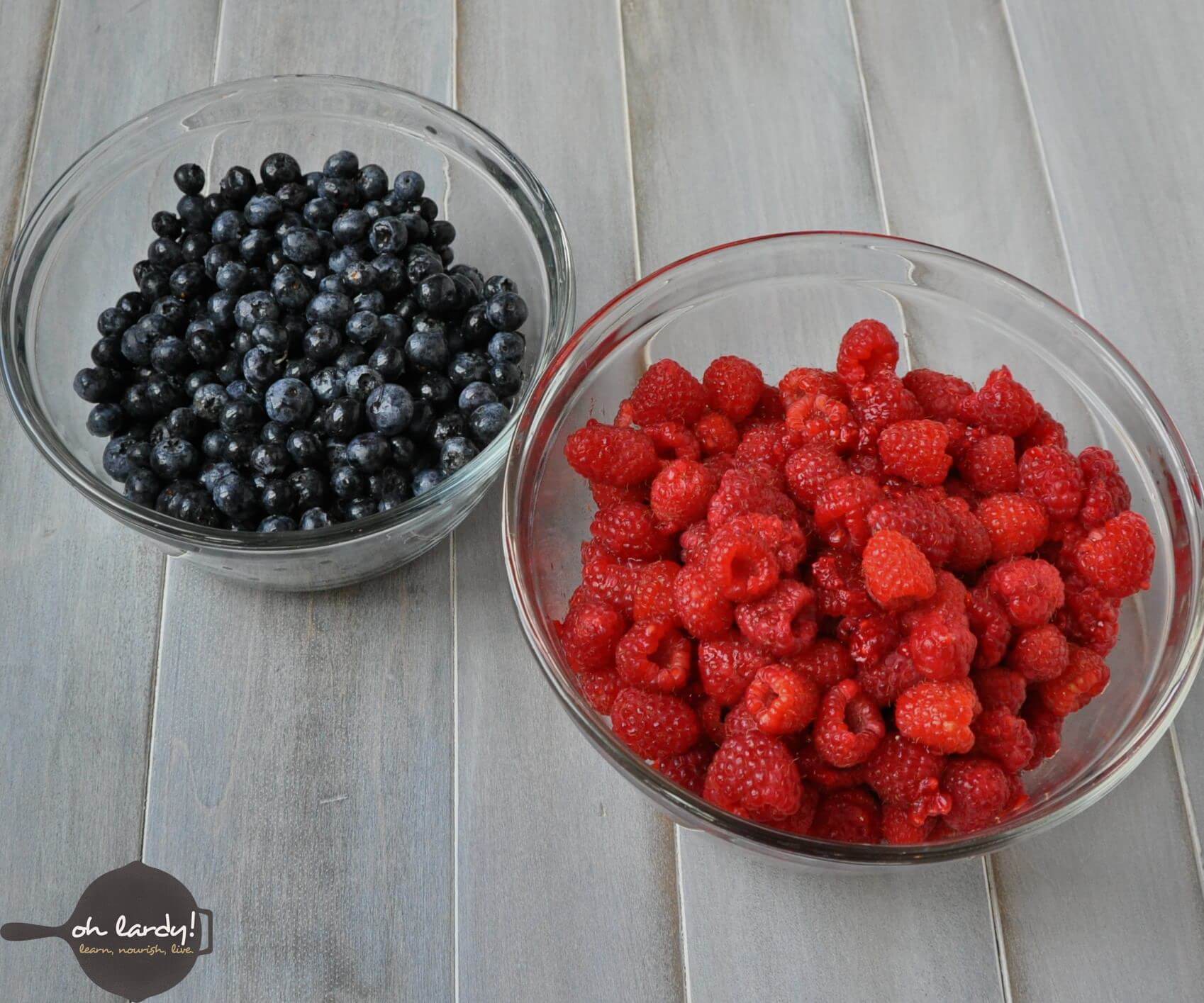
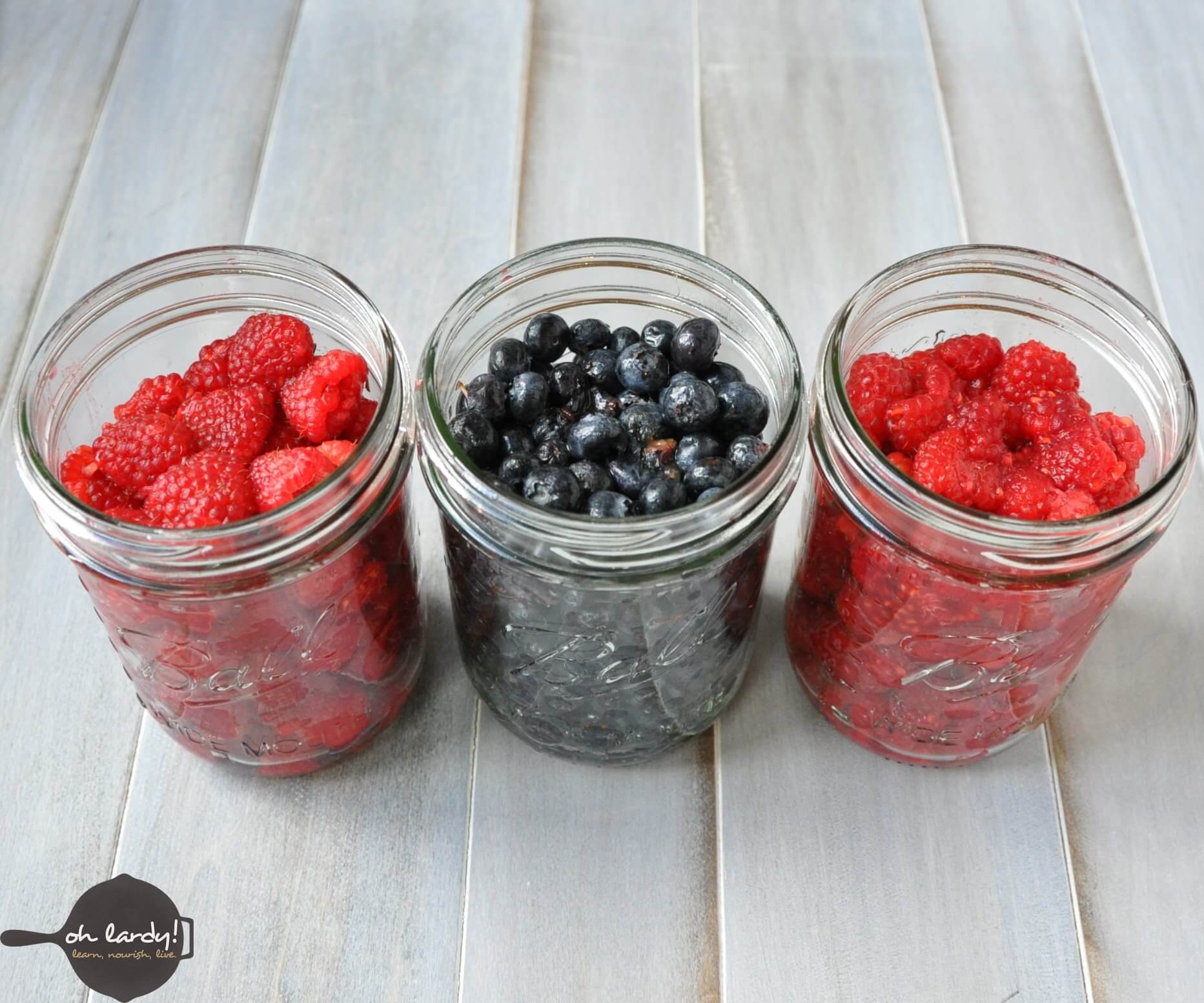
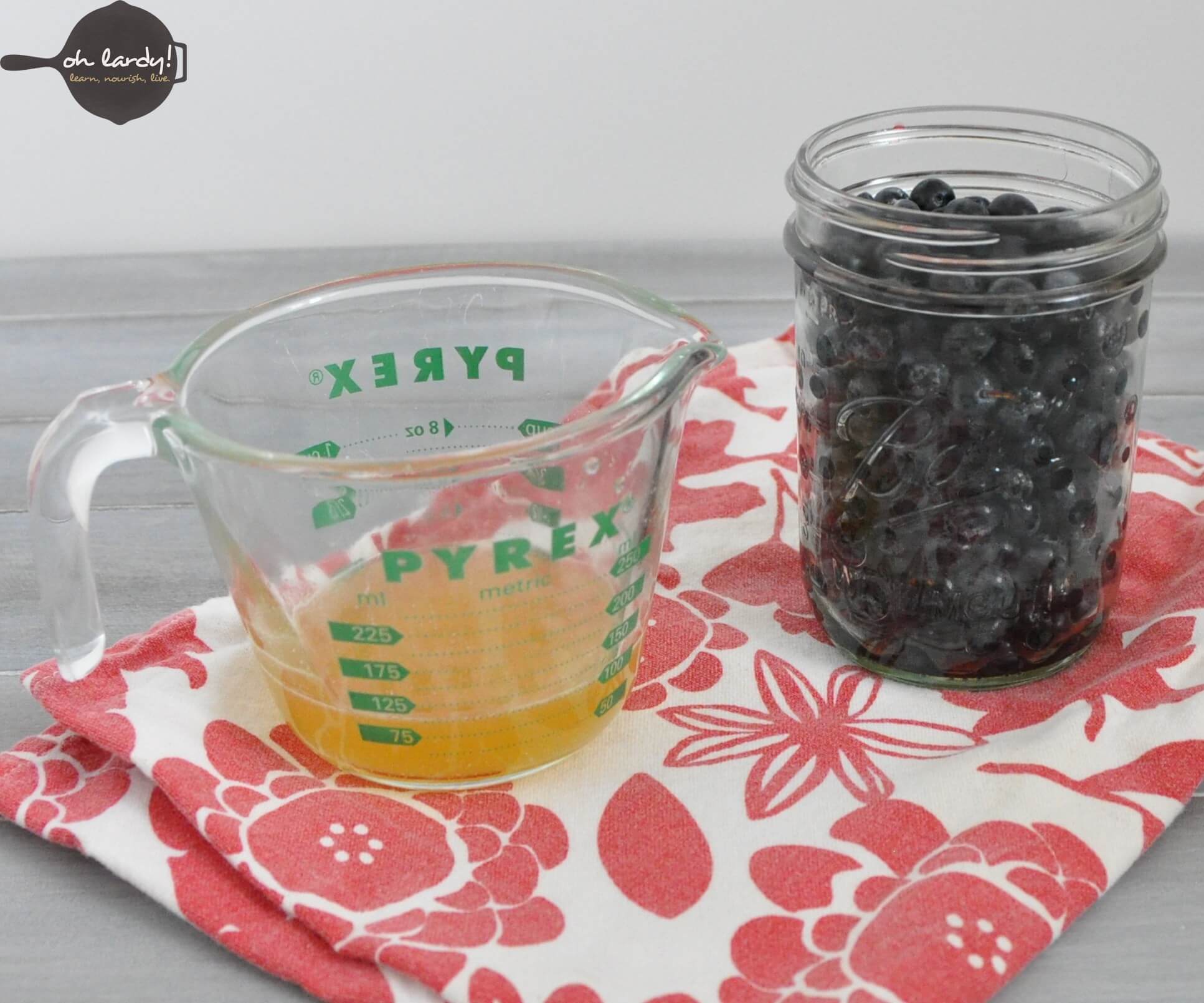
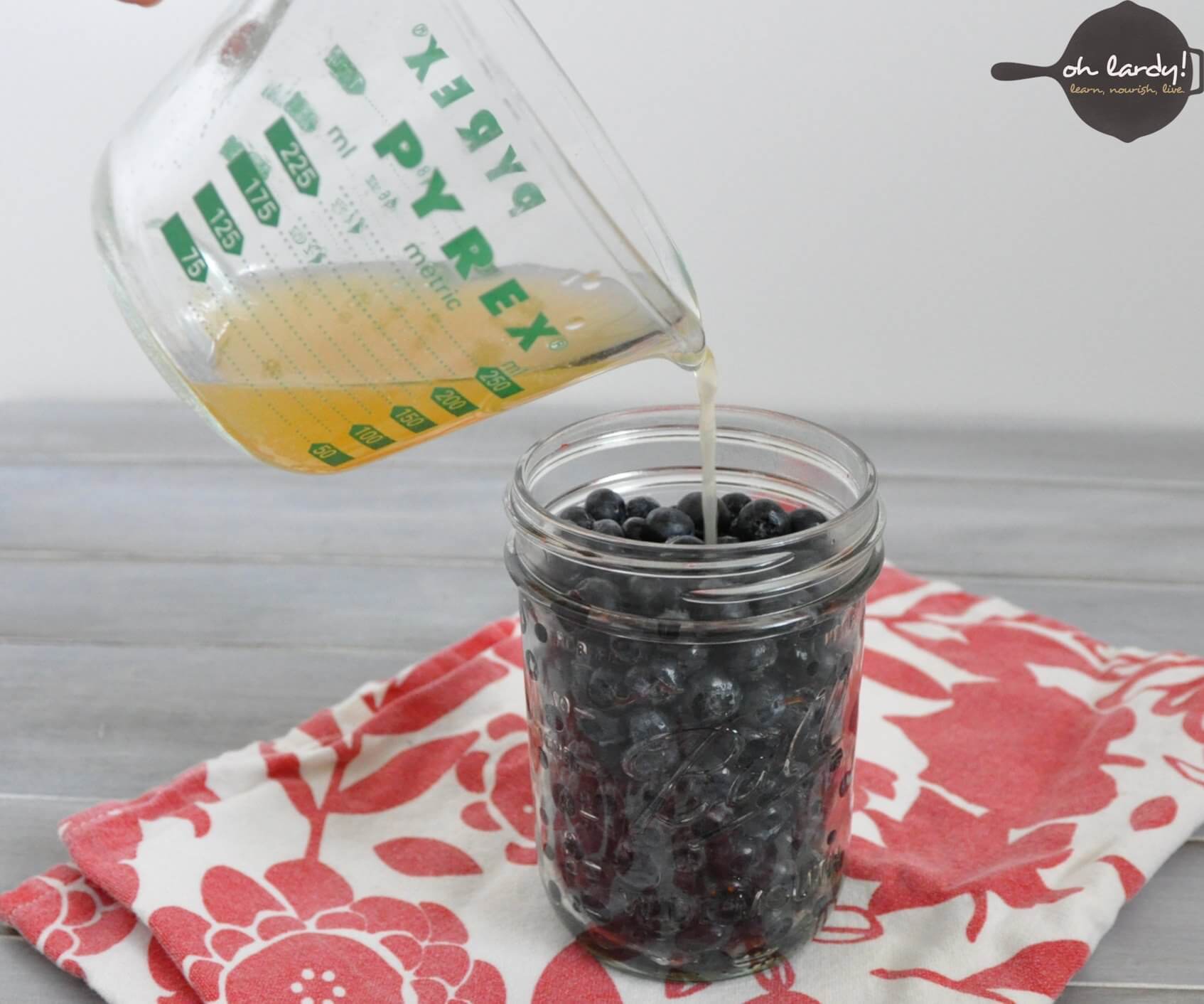
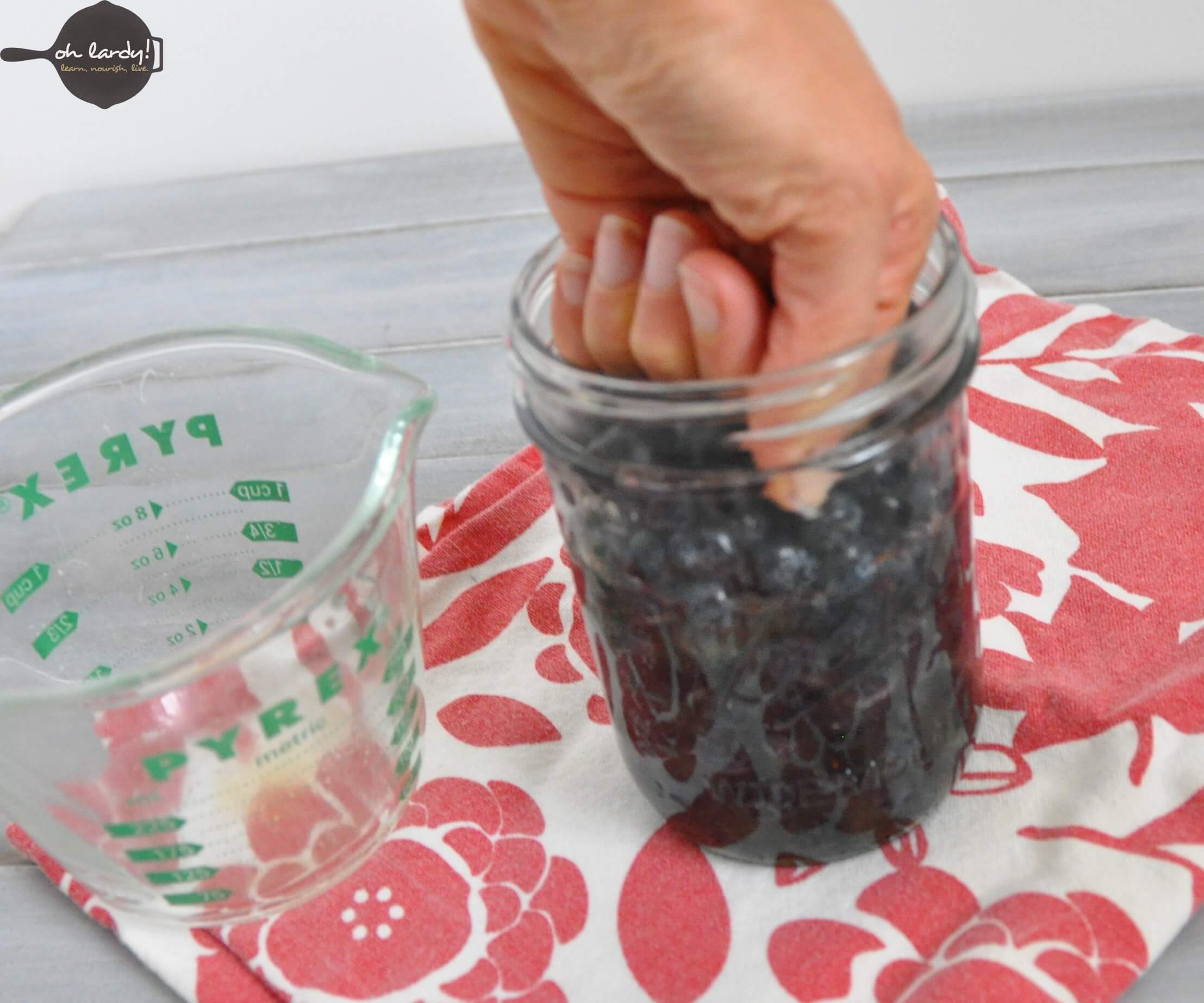
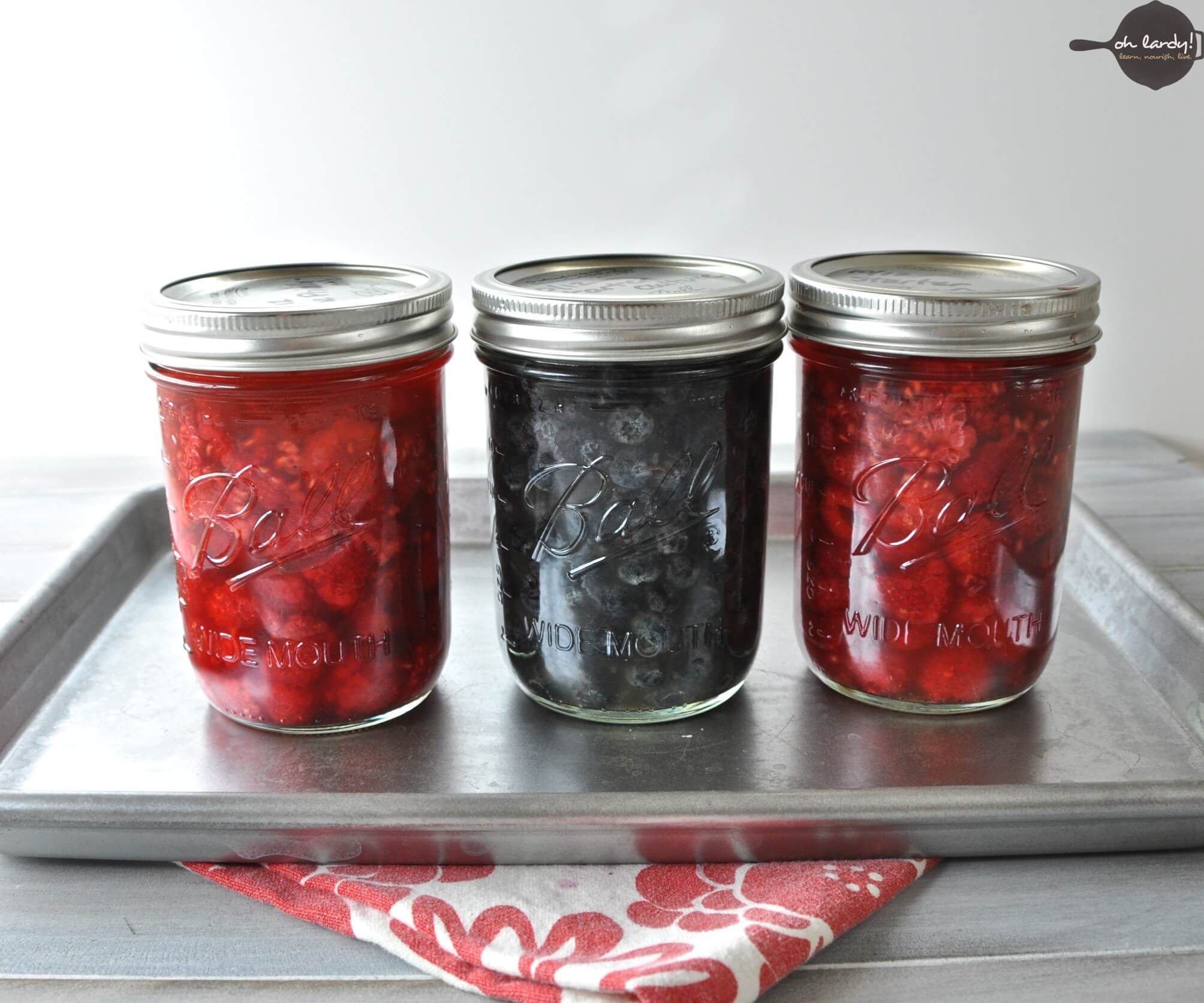
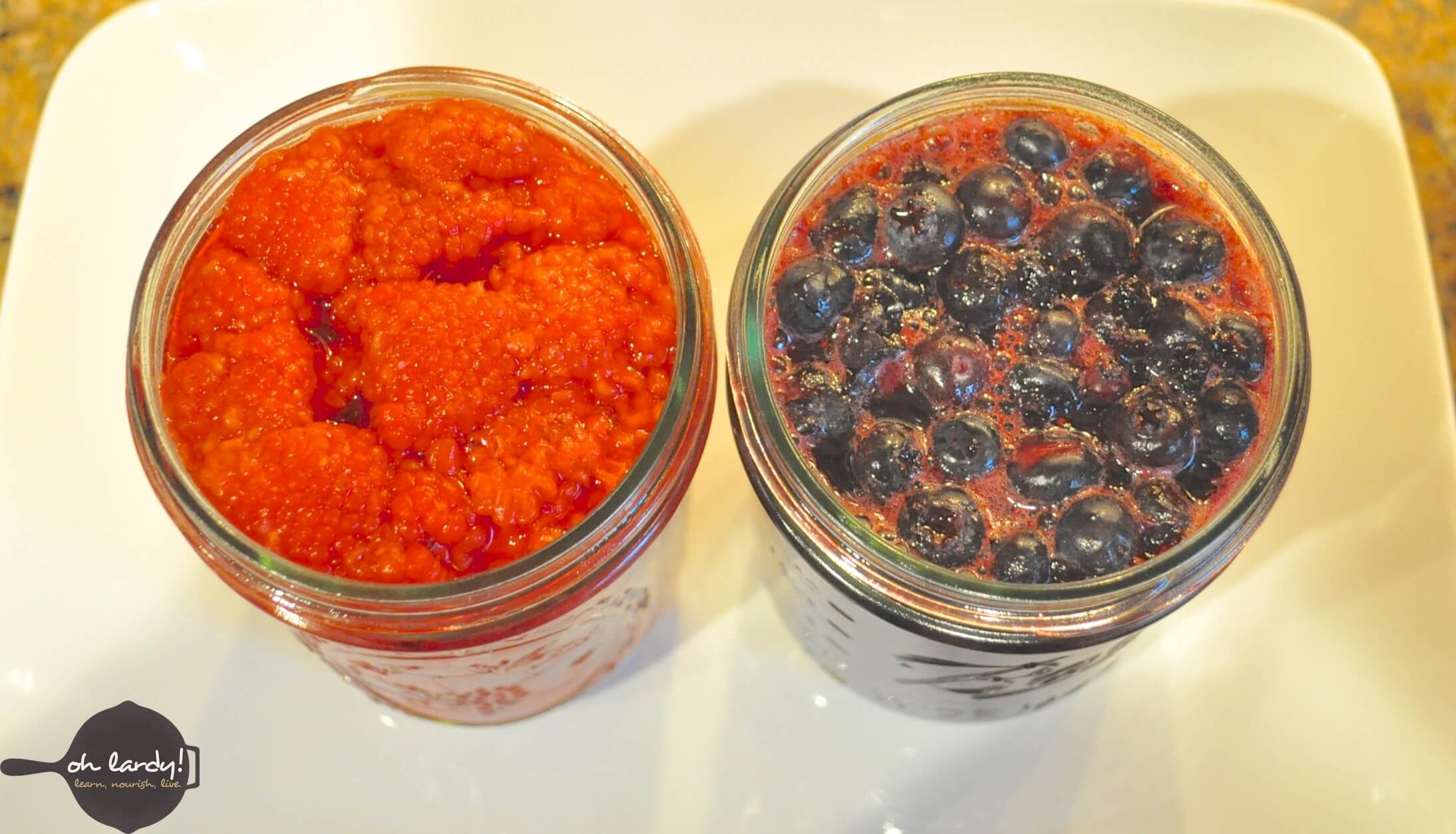
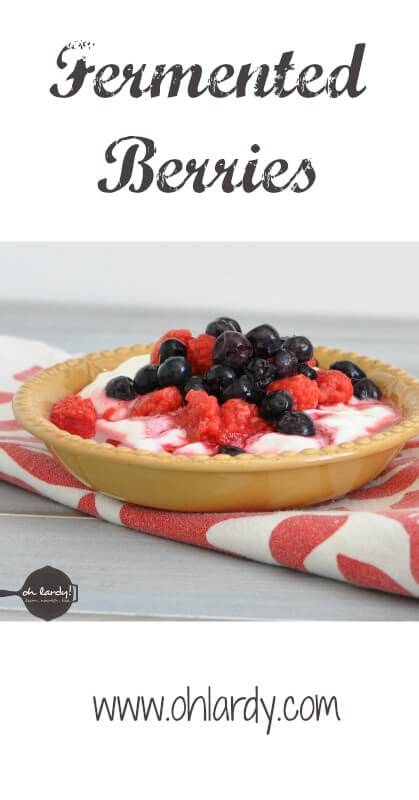
Wow I love this idea! I may have to try this next spring. Berry season is always way too short! This way it could last longer!
Yes, berry season is always too short! I was glad to discover that frozen berries work well too! I have 10 lbs of organic blueberries in my freezer from summer. Now I need to stock up on even more next summer! Enjoy!
Great idea! I have been foraging for a lot of berries this month, and have been using them for wine or lacto-fermented drinks, but this is perfect for smaller quantities!
Glad you like the idea! They are really tasty. Hope you enjoy!
So should my lacto-fermented berries replace the probiotic I take? What’s considered a serving size?
From what I understand a serving size of probiotic foods is approx 1/4-1/2 cup. I still take a probiotic supplement, but not every day. If I have not been consuming many probiotic foods that day, I will take the supp. Or if I am traveling, feeling run down, etc. I take the supp. I will say when I consistently get 3+ servings of fermented foods/drinks (including yogurts, cultured sour cream, kombucha tea, etc.), I notice a huge difference in my energy level, my digestion and general wellness. -tm
From what I understand a serving size of probiotic foods is approx 1/4-1/2 cup. I still take a probiotic supplement, but not every day. If I have not been consuming many probiotic foods that day, I will take the supp. Or if I am traveling, feeling run down, etc. I take the supp. I will say when I consistently get 3+ servings of fermented foods/drinks (including yogurts, cultured sour cream, kombucha tea, etc.), I notice a huge difference in my energy level, my digestion and general wellness. -tm
I don’t see bubbles (yet). Can I open up the jar and look? If I don’t get bubbles within 2 or 3 days, should I toss them and start over?
You can open and look. You may not always see bubbles. After 2-3 days, taste them. They should taste less sweet, a little sour (depending on what berries you used). You can also give the jar a gentle shake to look for bubbles. What starter did you use? Is it in a fairly warm spot? My kitchen is so cold in the winter. I have halogen under cabinet lights. I leave them on over my fermenting area to keep my jars slightly warmer.
I think they’re fine. They aren’t as fizzy as the first batch I did, but I might have left the first batch out too long and gotten a little fermentation!
Glad they worked out! Your senses (smell and taste) will be able to tell you when a fermentation has gone south. Enjoy your berries!!
What purpose does the honey serve?
From my understanding, it gives a little more ‘food’ for the bacteria. The end product is definitely not sweet, so I don’t think it adds a sweet taste.
Thank-you so much fro this recipe. I have oral allergy syndrome which obligated me to give up raw fruits due to cross-reaction. I’m glad I have a way of eating berries without experiencing any allergic reactions. However, I wonder if the levels nutrients and antioxidants in berries decrease when fermented or are they intact?
The nutrients and antioxidant levels are intact and some nutrients are even increased due to fermentation! Enjoy!
What, exactly, do these berries taste like after being fermented?
What specific “starter” do you need for this? The link takes me to a page with several different types of starters…the Kombucha?
I use the Body Ecology vegetable starter on Cultures For Health.
Is there anything you can use in place of a starter or whey? I have neither and have been wanting start ferments.
You could try a wild ferment and just add a couple tsp more salt but the resulting product might be too salty. Whey is easy to get from straining yogurt. http://www.ohlardy.com/nicely-making-whey
You could try some plain kombucha tea or the contents of some probiotic capsules too!
Can i use water kefir instead of whey?
I don’t see why not. I think any fermented liquid work work well as a starter since it would be adding good bacteria to the mix!
When will you be doing a fermenting class in Libertyville, Lake Forest, or nearby?
Thanks.
Hi Susan! Check out my website for events
http://www.tamaramannelly.com/events
I am teaching a fermenting class next Wednesday at elawa farms! I also do small group in home classes if that ever interests you!
Hope to see you at a class soon!
i have a few yogurt starter packets by yogourmet brand. would that work or do i need to buy another kind of starter? i also make my own kefir and there is usually some clear whey at the bottom of the jar.
i have probably 15 lbs of raspberries from the summer that i’ve had frozen. not sure what to do with all of them but i think this would be worth a try.
I have never used yogurt starter packets before. They whey at the bottom of the kefir would work for sure! Maybe try the yogurt packets with a small quantity of raspberries to see? Good luck and let us know what happens!
Hi, thanks for the ton of good info. I have questions I really hope you can help me with though.
I’ve been making fruit ferments (on my 3rd batch now) using grapes and blueberries. I use 2 probiotic capsules as my starter, with no yeast. The fruits look like they’ve been fermented well (sour, a bit mushy) but they have also been alcoholic. I’m confused as to why this would happen since I didn’t introduce any baker’s yeast. Do you have any idea?
I don’t have an issue with the alcohol (it’s only noticeable when I take a first whiff). Overall I get a very tasty drink, which I’m happy about, but will I still get any good bacteria from my batch? Because that’s my whole goal of doing this. I’m worried that I’m only getting alcohol and the by-products of yeast fermentation (like beer or wine)… Does having alcohol lessen/kill the good stuff that I really want?
Thanks in advance and sorry for the many questions!
p.s: Happy New Year 🙂
Curious, how do you know, besides smell, that it is alcoholic? Almost all fermented foods have some minimal alcohol as there are natural yeasts in the air and on the food. Fruit ferments fast and can turn alcoholic. There should still be good bacteria in the mix. Kombucha tea is a good example…has yeasts, good bacteria and a wee bit of alcohol. I would keep eating it but maybe next time ferment a little shorter time? How long are you fermenting?
It’s only smell that tells me it’s alcoholic. My first batch was stronger and drinking it gave me a slight buzz on an empty stomach.
I ferment for 6-7 days, when the bubbling has almost stopped (but still going on). I’m not sure what’ll happen if I let it ferment until the bubbling completely stops.
I was planning on fermenting for 1-2 days for my first batch, but the liquid was still quite sweet when I taste-tested then, so I let it continue to ferment for almost a week.
Thanks for confirming there’s still good bacteria 🙂 I got really confused because when I googled it there’s all these reports about how drinking alcohol is bad for good bacteria in the gut and I didn’t know what to think…
I’m going to try other fruits besides grapes and berries. It might help if they’re less sweet to begin with so I can have shorter ferments.
Thanks again!
That might be why fruit should only be fermented for 24-48 hours (depending on the warmth of the kitchen). Longer time will result in alcoholic fruit! (Not always a bad thing 🙂 )
adding bacteria to a sugar ( which is the honey in this case ) and left for too long will turn to alcohol. than if left longer will turn to vinegar. All steps are safe and rewarding in their own way. Making vinegar in this way makes it a stable vinegar and able to keep outside a fridge and for a long time.
If I use frozen berries do I defrost them first?
Yes. Defrost them and then proceed as normal!
I am eating these right now with milk kefir and they are OH-MAZING! Wow-these are my new favorite ferment now. Thanks so much for the fabulous recipe/idea.
So glad to hear that! Thank you for sharing!
Tried raspberries and blueberries and loved it! I’m wondering if one could do apples or mangos?
Have made a first batch using feijoa and it is amazing. Looking forward to having them at breakfast with cultured cream!!! Kids almost as excited as me. Thanks for the fantastic recipe.
That’s great!!!!
This is great timing for me to read this! My husband insisted on buying a cantaloupe about a month ago, but I get a little allergic reaction from cantaloupe so I knew it was going to waste. I cut it up and put it in mason jars in the fridge, where it has sat since then. (I KNEW he wouldn’t eat it!) So yesterday, I noticed it was not growing mold and I thought, I wonder if it’s fermented! When I opened the cap, air rushed out and I knew it was. I ate one chunk and it was carbonated and tangy. Wowza, now that was a healthy dose of probiotics! I love accidental fermentation, lol.
Great post, thank you for the tips so I can do it purposefully next time!
Great recipe: I agree that they may be more enzymes, but more vitamins? Where do they come from. If rapidura is essentially brown sugar, can I just use that?
You can use any sugar. The less processed seems to give the best results. There is numerous information out there about how bacteria (during the fermentation process) produce more vitamins as they are digesting the starches and sugars in the food. (particularly B vitamins and K2).
So I just opened my jar of fermenting berries and I didn’t see any bubbles, I did see a little bit of mold around the top. Should I throw them out and start over? I used blackberries and whey starter, checked them after 48 hours.
TIA
If there is mold, yes you should throw them out. Bummer! Were the berries completely covered with liquid?
I just purchased your guide to fermenting, and am so very excited to try the recipes. I have some berries in the fridge that I’m anxious to prepare tonight.
My plan is to make my own whey for fermenting, but know I won’t have that ready tonight. I’m trying to figure out alternatives that I might have readily available at our local whole food store or something I have on hand.
I’ve heard of powdered whey. Is that something that can be used as a culture starter if liquid is not available?
Powdered whey will not work. All you need to get whey is to strain plain yogurt. For a small batch of berries, the liquid that is already at the top of yogurt will work fine. You don’t need much! Also, if you have probiotic capsules that contain ‘lactobacillus’ strains of bacteria, you may be able to open a couple of those to use as a culture starter!
Thanks so much for the prompt reply, and for all of the wonderful information on your blog an in your eBook. I’m off to ferment some things!
Awesome!! Enjoy!!
For people who have medications that conflict with alcohol, fermented fruits can cause an issue, because they build a significant alcohol content while fermenting (anything with sugar or fructose does). An airlock fermentation, or closed lid fermentation during the first two weeks will reduce the initial alcohol content, but a more open container after that will then allow the alcohol to evaporate and vinegarize after the first two-three week active fermentation period.
Can maple syrup sub for honey? I’d like to give it to my infant but they can’t have honey under 1 year old. Does the fermentation process eat the sugar up like in kombucha so if I use sugar it won’t be like giving her something sugary?
Yes, the fermentation process eats the sugar (most of it). You could use maple syrup or any other type of sugar you like!
Why not strawberries?
I am not sure but Nourishing Traditions says they don’t ferment well!
Can i use Organic Stevia instead of honey?
No, stevia will not provide food for the bacteria. You could sweeten with stevia after fermentation if you wish.
Do you think I could put these in a water bath or pressure canner to make gifts for Christmas? I have a great blueberry crop this year and LOVE this recipe. I’d like to have them for more than just the fall.
If you use a water or pressure canner you will lose all the fermentation benefits…all of the good bacteria will be killed. Fermentation is, on its own, a form of preservation that is alive. You could freeze your blueberries and use thawed berries for the recipe closer to Christmas. They work just fine! You made need slightly more berries than the recipe calls for if they are thawed!
My berries taste a bit like vomit. What went wrong?
Hmm…vomit? They may taste a bit sour or ‘fermenty’, sometimes even yeasty. Is there mold or any visible sign of problem? I am honestly not sure but things definitely can go wrong in fermenting.
No mold, and they definitely taste and smell like vomit. Maybe it’s too much yeast? Thanks.
Bummer! I have no idea. Hopefully next time you have better luck! 🙂
These fermented berries look awesome! I came across your website when looking for tips on fermenting grapes into a jam/chutney. Have you ever fermented grapes? I bought a bag of them yesterday and they are way too sweet for my taste… so I figured let the bacteria eat some of the sugar… I just don’t know how to go about fermenting grapes… would you have any suggestion for me?
Thank you!
I have not fermented grapes but if I were going to give it a go, I would use the same technique as the berries! Good luck and let me know how they turn out!
I just started learning how to lacto-ferment veggies and was informed that if you use enough salt you don’t need whey. Does the same apply for fruit? I don’t have whey or plain yogurt and already did it without…does this mean it won’t work…… or does it just take longer? 🙁
I have never had luck not using a starter for fruit. It is true that you can use more salt and no starter for vegetables. But doing the same for fruit would result in salty fruit which I think would be gross. You could try just using a pinch of salt and leaving out the starter. See what happens!!
I’m not sure why but tgis web site is loading incredibly slow for me.
Is anyone else having this problem or is
it a issue on mmy end? I’ll check back later and see if the
problem still exists.
I’ve preserved berries with lactose-fermentation before using more salt and no starter culture. It worked but it was salty. I used this recipe (with organic sugar rather than honey) and a commercial starter culture (I had Body Ecology and Caldwells) and it is yummy. My berries were black and red currents, gooseberries and sour cherries. I did some of each and a mix. I think I like the mix and the sour cherries best at this point, but all are fine. I had pickling lids with air locks and I collected the juices that overflowed (and drank it – quite nice!). It is such a short process with fruits and a strong starter culture!
I am happy to have a way to use the whole berry and never expose it to high heat. I’ll freeze most of the berries, since fridge space is limited, but I like the addition of the fermentation process, so I’ll make more when I exhaust the four pints I fermented this week.
I have started making drinking vinegars also called shrubs. I have gallons of fresh currants and wpuld love to use fermented currants and then add the ACV to make a shrub. Do you think this would work? Right now I use fruit, sugar (in the fridge) and then I strain the fruit, add an equal amount of Bragg’s ACV and let set in the fridge for a couple weeks. So not truly a ferment. Do you think I can ferment then add ACV?
Thanks for sharing your thoughts on susan boyle weight loss.
Regards
I made these a couple of fays ago and tasted them today. Thank you for the recipe. They are interestingly delicious. I do have a question. My blue berries were very leathery, took some doing to chew up the skins. What’s up with that?
Glad you liked it! Not sure about the blueberries. I haven’t had that happen. Maybe just the nature of that particular batch of blueberries?
Have you ever fermented Aronia berries. Do I have to use a starter culure or whey, Won’t the berries ferment like cabbage with salt and water? Cheers, Sam
I am sure they could be fermented! Try it and let us know how they turn out. I like to use some sort of a starter wiht fruit ferments, personally.
after putting the cucumbers in the jar, keep the jar tightly closed or just cover with the paper
after putting the fruit in the jar, keep the jar tightly closed or just cover with the paper
Thanks for sharing,
it’s very informative for me.
I also find some relevant articles.
susan boyle lost weight
Cheers.
I often add a couple of chopped apples when making sauerkraut and it is lovely – a hint of fruity sweetness with the sharp. I am thinking of adding some blackcurrants when they are in season. I have tried all sorts of things, spices herbs etc, the only thing that was a disaster so far was parsnip – maybe I put in too much – it bubbled for a long, long time and ended up very alcoholic and not nice at all. It was horrible having to bin 3 litres of hard work! I’m thinking blackcurrants could work as they are not overly sweet. I was googling (duckduckgo-ing actually) to see if anyone has tried this. My freezer is not big enough for the blackcurrants I usually pick (from my one bush). I hadn’t realised they could be fermented on their own. Will try a small batch.
Thanks for sharing,
it’s very informative for me.
I also find some relevant articles.
susan boyle weight loss
Cheers.
Thanks for sharing,
it’s very informative for me.
I also find some relevant articles.
susan boyle weight loss
Cheers.